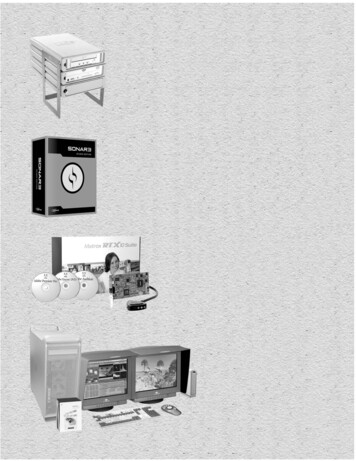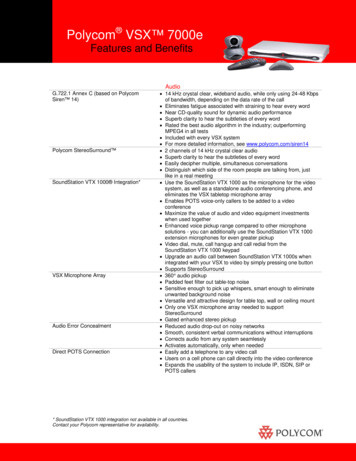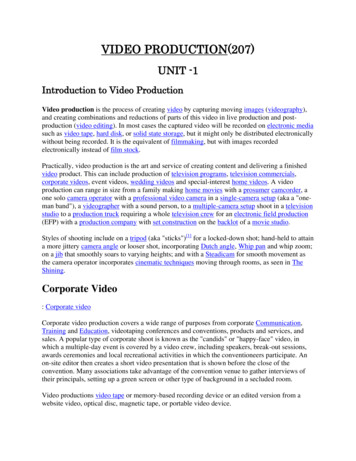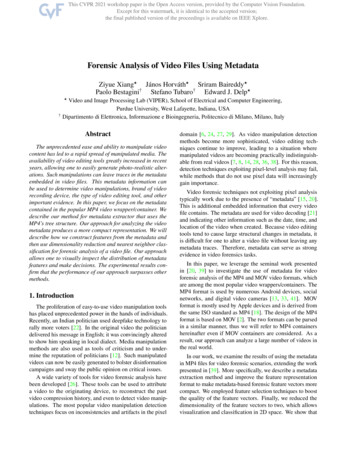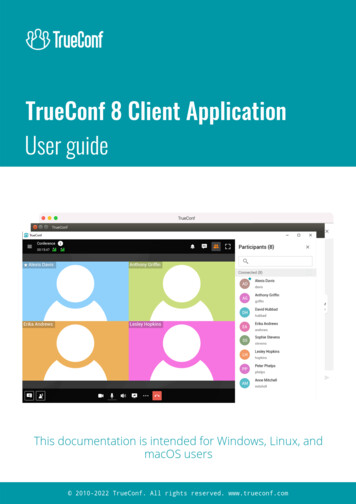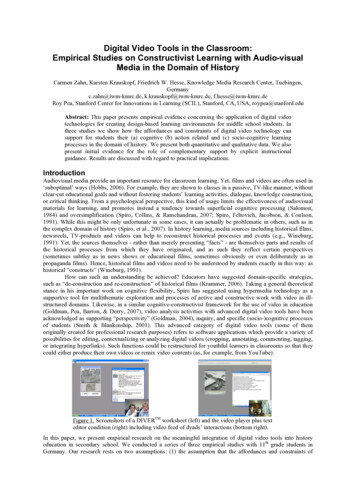
Transcription
Digital Video Tools in the Classroom:Empirical Studies on Constructivist Learning with Audio-visualMedia in the Domain of HistoryCarmen Zahn, Karsten Krauskopf, Friedrich W. Hesse, Knowledge Media Research Center, Tuebingen,Germanyc.zahn@iwm-kmrc.de, k.krauskopf@iwm-kmrc.de, f.hesse@iwm-kmrc.deRoy Pea, Stanford Center for Innovations in Learning (SCIL), Stanford, CA, USA, roypea@stanford.eduAbstract: This paper presents empirical evidence concerning the application of digital videotechnologies for creating design-based learning environments for middle school students. Inthree studies we show how the affordances and constraints of digital video technology cansupport for students their (a) cognitive (b) action related and (c) socio-cognitive learningprocesses in the domain of history. We present both quantitative and qualitative data. We alsopresent initial evidence for the role of complementary support by explicit instructionalguidance. Results are discussed with regard to practical implications.IntroductionAudiovisual media provide an important resource for classroom learning. Yet, films and videos are often used in‘suboptimal’ ways (Hobbs, 2006). For example, they are shown to classes in a passive, TV-like manner, withoutclear-cut educational goals and without fostering students’ learning activities, dialogue, knowledge construction,or critical thinking. From a psychological perspective, this kind of usage limits the effectiveness of audiovisualmaterials for learning, and promotes instead a tendency towards superficial cognitive processing (Salomon,1984) and oversimplification (Spiro, Collins, & Ramchandran, 2007; Spiro, Feltovich, Jacobson, & Coulson,1991). While this might be only unfortunate in some cases, it can actually be problematic in others, such as inthe complex domain of history (Spiro, et al., 2007). In history learning, media sources including historical films,newsreels, TV-products and videos can help to reconstruct historical processes and events (e.g., Wineburg,1991). Yet, the sources themselves - rather than merely presenting “facts” - are themselves parts and results ofthe historical processes from which they have originated, and as such they reflect certain perspectives(sometimes subtley as in news shows or educational films, sometimes obviously or even deliberately as inpropaganda films). Hence, historical films and videos need to be understood by students exactly in this way: ashistorical “constructs” (Wineburg, 1991).How can such an understanding be achieved? Educators have suggested domain-specific strategies,such as “de-construction and re-construction” of historical films (Krammer, 2006). Taking a general theoreticalstance in his important work on cognitive flexibility, Spiro has suggested using hypermedia technology as asupportive tool for multithematic exploration and processes of active and constructive work with video in illstructured domains. Likewise, in a similar cognitive-constructivist framework for the use of video in education(Goldman, Pea, Barron, & Derry, 2007), video analysis activities with advanced digital video tools have beenacknowledged as supporting “perspectivity” (Goldman, 2004), inquiry, and specific (socio-)cognitive processesof students (Smith & Blankenship, 2001). This advanced category of digital video tools (some of themoriginally created for professional research purposes) refers to software applications which provide a variety ofpossibilities for editing, contextualizing or analyzing digital videos (cropping, annotating, commenting, tagging,or integrating hyperlinks). Such functions could be restructured for youthful learners in classrooms so that theycould either produce their own videos or remix video contents (as, for example, from YouTube).Figure 1. Screenshots of a DIVERTM worksheet (left) and the video player plus texteditor condition (right) including video feed of dyads’ interactions (bottom right).In this paper, we present empirical research on the meaningful integration of digital video tools into historyeducation in secondary school. We conducted a series of three empirical studies with 11th grade students inGermany. Our research rests on two assumptions: (1) the assumption that the affordances and constraints of
digital video technologies—particularly constructive video tools allowing for annotating, editing (e.g., zoomingand cropping), and re-sequencing—have opened up new vistas for making video accessible to constructivistlearning in school-based education and beyond (Zahn et al., 2005) and (2) the general assumption that framingsuch video tools in constructivist design tasks can be effective (Zahn, Krauskopf, Pea & Hesse, in press). Weworked with a video tool which has been created specifically to support both cognitive processes andcollaborative learning with digital videos (the DIVER/WebDIVERTM system, Pea et al., 2004, see Figure 1). Itsupports cognitive processes such as focusing attention within a complex and dynamic visual array. It includes aset of specific editing capabilities which enable users to extract, rearrange and comment on scenes or videosegments aiming at the support of important visual analytic skills of learners, such as focused observation. Theselected and commented items are called dives, based on users "diving" into a video by zooming in on scenesand details of the video by controlling a selection frame or “virtual viewfinder”. A dive consists of re-orderable“panels”, i.e., clips and corresponding comments that are shown in a separate column next to the source video.As a result, sequences and details of a video are not only being cognitively selected, but these video selectionsand interpretive annotations become new, replayable artifacts that have persistent references as URLs. This iswhy the system is also considered a collaborative tool: These replayable artifacts can be collaborativelyproduced and shared with others for joint reflection, analysis and discussion (“Guided Noticing” ). Intransferring these design rationales underlying the DIVER/WebDIVERTM system or similar tools to theclassroom (Zahn et al., 2005), we investigate in our research both the new opportunities and the new challengesarising for students, and ultimately teachers. From our point of view , there are many opportunities to createbetter conditions for active learning with video materials and relate them to effective processes of knowledgebuilding (Scardamalia & Bereiter, 2006).For instance, students may work creatively with digital videos, whichare already available as audio-visual sources online. They can suggest new ways to approach these media andthus enable subsequent users to integrate the reflections of others, which ultimately leads to the development ofcore competences, such as historical reasoning, advanced expertise (Scardamalia & Bereiter, 2006) or newmedia literacies (Jenkins, Clinton, Weigel, & Robison, 2006). The challenges include the adequate framing ofThe main challenge is to frame these collaborative tools with the right tasks to create powerful learningenvironments, in order to reach the learning goals during classroom- based instruction.Visual Design to Frame Learning with Digital Video ToolsTo investigate both the opportunities and the challenges of using advanced video tools for constructivistlearning in history lessons, we apply design approaches to learning, i.e., concepts of learning by creatingartifacts (e.g., learning through design, Kafai & Resnick, 1996; learning by design, Kolodner et al., 2003). Weconsider the design approaches especially suitable in our case, because they call for activity- and projectoriented learning with media. In this process, students can autonomously create something that seems authentic,meaningful and consequential for them, which gives them the opportunity to experience themselves ascompetent and intrinsically motivated learners (Beichner, 1994). In addition, from a cognitive perspective, adeeper understanding of the complex topic area and video content can be expected: Acting as designers,students are creating a new video-based information structure. This requires them to select, compare and reflecton the content they wish to present and on how to present it, which results in a positive influence on knowledgeacquisition for a complex topic, as in writing (Hayes, 1996). Based on the work of Lehrer and Erickson(Erickson & Lehrer, 1998; Lehrer, Erickson, & Connell, 1994), the ideal structure of a design process includesplanning, transformation, evaluation and revision. Design projects thus should support the development ofgeneral problem solving skills as well as specific skills related to media competence. Learners not only need toplan the information structure they are going to create, they also must creatively integrate different mediaformats in order to combine them effectively for a sensible form of the information presented. In an attempt tointegrate the cognitive models of writing and design with constructionist (constructivist?) perspectives, and inorder to apply them to the case of video-based design, we proposed elsewhere a tentative model of collaborativevisual design as a process of joint dual space problem solving (Zahn, Krauskopf, Hesse, & Pea, 2009). In thismodel, we hypothesize visual design to be a collaborative problem solving process involving intensiveinteractions between video content and form (audience-related goals), in a rhetorical problem space. Based onthis model, we shaped our research around the following research questions: How do the affordances of advanced digital video tools impact (a) cognitive (b) action related and (c)socio-cognitive processes of students learning a historical topic? How do students approach visual design tasks in a real history class? When and how can explicit instructional processes optimize the implementation and utilization ofdigital video technologies?For the purpose of our empirical research, we developed a prototypic visual design task for German historylessons, where students were asked to rework a video source showing an historical newsreel on the 1948 Berlinblockade. With varying digital video tools at hand, learners elaborated on the video source by integratingadditional information provided, with the goal of creating an artifact that could be published online for future
(peer-)learners. The task included critical reflection and comments on the historical content as well as onnewsreels as a means of propaganda in former times, based on examples from the source video. Whether theaffordances of digital video tools used in the context of our creative task would clearly have a positive effect onstudent understanding in a real history class was an open empirical question. It was also an open questionwhether the affordances and constraints of different digital video tools differentially influence student learningand if so, whether they would affect specific task elements. In general, we assumed the visual design task andthe affordances of digital video tools would have an impact on three levels: (a) the cognitive impact wasassessed by multiple choice items tapping historical knowledge and transfer tasks for critical film analysis. Weinvestigated the design products of participants as indicators of (b) action-related outcomes by considering theirnumber of selected scenes and sequences, precision (length of sequence and size of detail), and structuring(deviations from the source video’s chronology). Finally, we analyzed the dyads’ taped interactions asindicators of (c) socio-cognitive effects by using a coding scheme that captures students’ problem solvingbehaviors (planning, executing, evaluation, revision), collaborative behaviors, and content discussed (theoriginal newsreel-video, the historical events, or their design task). In addition, we analyzed selected caseexamples of dyads’ interactions to provide empirical evidence for the impact of the affordances of the advanceddigital tools on collaboration.The visual design task was tested in a lab-experiment (see Zahn, Pea, Hesse, & Rosen,in press) undercontrolled conditions to investigate its general effectiveness. Also, the specific effects of the affordances of thedigital video tool WebDIVERTM, in contrast to a control condition using “simpler” technology (video-player &text-editor) had to be proven before we took the procedure into studies with high school students in theclassroom. The sample of this first study consisted of 24 dyads of psychology students (mean age 22.2, SD 4.8, 68.8% female). Generally the results revealed high appraisal of the task and significant positive mediatingeffects of the WebDIVERTM video tool on all three levels of outcomes described above: Dyads supported byWebDIVERTM showed higher factual knowledge and film analysis skills, design products of higher quality, andmore communication time devoted to task relevant content (historical context and design decisions). In sum, theresults showed that the influence of the video tools extended to the learners’ socio-cognitive processes andfocused their interactions on the task. Qualitative case analysis provided evidence for direct effects of the videotools on conversations, i.e., tool affordances implicitly guided learners’ elaboration on the source video.Field Study in ClassFollowing up on the results from this preliminary laboratory study, we took the experimental design intoGerman secondary classrooms. The experimental sessions were conducted in schools spanning over twosubsequent 45 minute units using a portable “notebook classroom” we provided for the study. The students werealerted by teachers that our task would be integrated into the current history curriculum. In this study wemanipulated two experimental between-subject factors in a two-way factorial design. The first factor(technology) was the digital video tool provided to the students (digital video tool DIVERTM vs. simplersoftware solution, i.e. video player combined with text-editor). The first factor was chosen to test the ecologicalvalidity of the results found in the prior lab experiment on the specific effects of the affordances of the digitalvideo tool WebDIVERTM. By investigating effects of tool affordances, we wanted to address the importantissue of whether or not an editing tool originally designed for researchers and educators, when reapplied as atool for learning in the classroom, would be beneficial for students in comparison to a common (and maybemore familiar) technology. The second factor (metaphor) was the appeal to students’ media-related rhetoricalconcepts –their rhetorical concepts were either in line with or different from the system architecture of thedigital video tool). By introducing this second factor, we wanted to tap into the question of explicit instructionalsupport of the complex design task as opposed to the implicit guidance by the digital tools. We based this factorof metaphor on the work of Stahl and Bromme (2004), who investigated students designing hypertexts andreported that, due to the novelty of the medium hypertext, student designers cannot be assumed to have firmlyestablished media-related rhetorical concepts which form a design goal. Therefore, in the first condition weprompted students with a metaphor of “video dives” epitomizing the concept of a medium for selecting (“divinginto”) visual information. In the second condition we prompted students with a metaphor of “annotated movies”epitomizing the concept of a medium for integrating information elements.Altogether 234 students from 8 classes in 4 German secondary schools participated. Due to technicalproblems, data of 24 participants (12 dyads) could not be saved and were not included in the analyses. In theend , data from 111 dyads of students were analyzed (mean age 15.9, SD 0.78, 60.9% female). We are awarethat our data has a multilevel structure; however, due to the sample size and small number of classes, we basedour analyses on the dyadic level. Gender composition of the dyads was equally distributed over the fourconditions. Furthermore, experimental groups did not differ with regard to their experiences with digital media,personal computers, or prior knowledge of post-war German history. However, the groups using the DIVERTMtool reported higher initial interest in post-war German history. Thus, all reported analyses were additionally runwith interest as covariate without changing the results.
In general, the design task was rated by participants as being interesting in general and proved applicable in theclassroom. Also, with regard to cognitive outcomes, all students improved in their factual knowledge of thehistorical content, measured by a multiple-choice test before (M 45.20% correct, SD 15.50) and after thedesign task (M 65.00% correct, SD 8.20), F(1, 107) 230.83, p .05, partial η2 .68. However, there were nodifferential effects of the independent variables. The manipulation tapping students’ media concepts showed noeffects on either outcome variable, nor were there any significant interactions (F 1).With regard to the action-related outcomes, students using the advanced digital video technology(DIVERTM) created more sophisticated design products. They selected significantly more scenes and moredetails within these scenes compared to the control group. Furthermore, the DIVERTM tool increased the numberof deviations from the chronological order of the source video when students made the selections, whichindicates more autonomous design in the experimental compared to the control condition. Altogether, thisindicates that the advanced digital video tool fostered a higher quality of the design products.In line with these findings, dyads using the DIVERTM tool seem to have acted more autonomouslyduring collaboration: In order to analyze the socio-cognitive impact of the affordances of digital video tools oncollaborative design, the interactions of a random subsample (N 14 dyads) were coded for (a) content ofcollaborative talk and (b) problem solving behavior. 20% of the videos were coded by a second rater andaccording to Asendorpf and Wallbott (1979) we computed Cronbach’s α for ratio scales (here the aggregatedtime of students spent on the different activities) as the agreement measure. Overall, high inter-rater reliabilitywas found, all αs .81.The proportions of content discussed during the design task, relative to overall collaboration time,show a beneficial influence of the advanced technology. Dyads working with DIVERTM discussed the historicalcontent more substantially (M 14.22% of time, SD 7.37) and their actual design task (M 16.45%, SD 5.96),than did dyads in the control condition (M 5.33%, SD 6.56), F(1, 107) 6.42, p .05, partial η2 .39,respectively (M 7.23%, SD 6.55) F(1, 107) 7.78, p .05, partial η2 .44. In contrast, students working withthe less sophisticated video player and text-editor showed a tendency to discuss the source video itself more(M 18.64%, SD 8.36) than did students using DIVERTM (M 3.49%, SD 18.03), F(1, 107) 3.37, p .10,partial η2 .25. Overall, this indicates that the affordances of the advanced digital video tool influenced thedyads’ collaboration on a socio-cognitive level and may have fostered task-relevant discussion about historicalcontent and design.Students’ general problem-solving behavior, however, was influenced neither by the design tools northe prompted metaphors. All dyads directly engaged in executing the task (80.5% in general) and devoted lessthan 4% of their time to planning and evaluation. Analyses revealed a tendency for students to request help lessoften when using DIVERTM (1.63% time working on task, SD 2.13) than in the control condition (M 5.32%,SD 4.04), F(1, 10) 4.21, p .10, partial η2 .26). We interpret this as an indicator for a stronger implicitguidance of the advanced digital tool in situations when a task is not explained step by step but determined bythe goal. The coding of the video interactions also showed that overall “other” activities of learning dyads madeup less than 5% of the time on task. These activities included off-task behavior, such as chatting (M 3.90%,SD 3.58) and problems concerning the technology (M 3.67%, SD 2.82) and did not differ between the fourconditions, all Fs 1, ns. Therefore, any differences in students’ learning behaviors cannot be attributed todifferences in the difficulty of operating the two technologies.However, especially taking into account the limited time that students could spend on the design task,the quantitative indicators for learning outcomes document effects, not processes. In order to provide evidencewindows to substantiate our assumptions (see above: advanced digital video tools may support collaboration ona socio-cognitive level), we conducted additional case analyses focusing on giving what Barron (2003) calls a“localized account” on how the dyads integrated technology affordances in their conversations for their designrelated interactions. Such evidence was already found in the prior laboratory study (Zahn et al., in press), wherewe identified processes of “guided noticing” (Pea, 2006), which emerged as interactional patterns in dyadselaborating on a newsreel with WebDIVERTM. In the present paper, we provide evidence for similar findingsunder the conditions of the real “noisy” classroom setting. We compare two exemplary episodes for processes intwo dyads working with either DIVERTM (see Table 1) or the simpler technology of the control condition (seeTable 2). These dyads performed similarly well on the task and the post-tests. The episodes illustrate how thestudents from each dyad collaboratively work on the same scene in the historical newsreel video, but withdifferent orientations: Dyad 1 (Students A and B working with DIVERTM) discusses a design problem therebyelaborating on historical content, while dyad 2 (Students C and D working with a video player combined with atext-editor) discusses descriptive features of the source video while also sticking to its chronology.In dyad 1, during most of the episode the two students skim through the dive panels they had createdearlier, which results in several cycles of “guided noticing” (Pea, 2006). The transcript provided in Table 1illustrates how A guides attention to a previously selected picture. The joint attention of students A and B is alsoimplicitly guided by the technology’s affordances: In the beginning of the episode (lines 1-9) the students seek apicture as a focus of their joint attention and select it for their design product (while deleting another prior
selection). In the middle of the episode the question of student B about a necessary design decision (where toassign the caption “Air Lift”, line 11), initiates a short discussion (lines 12-16), which ultimately leads tomeaning-making about what “Air Lift” means (line 12) and what “Candy Bombers” are (lines 14-16). In otherwords: understanding of the historic event (the aim of supplying the population separate from the planes as ameans of reaching this aim and their name “Candy Bombers”) results from a simple question (line 11), whichresulted from the necessity to write and place a caption. This provides an example of how the tool’s affordanceimpacts socio-cognitive processes, joint meaning-making and the establishment of common ground, finallyleading to creating a design product. There is an additional factor suggested by the excerpt presented here:While the dyad diverges from the central goal in this episode—specifying what is meant by the term Air Lift—the dive panels created earlier repeatedly guide joint attention back on this goal. Students A and B finally recordthe different ideas emerging during their conversation, in other words, they arrive at closure, manifested in theirdesign product as a replayable artifact.Table 1: Exemplary Episode of Dyad 1 (Working with DIVERTM)Timestamp 00:13:27LineStudent UtteranceActions and written comments1AB scrolls up to the specified 21AABATimestamp15:53 – 16:09Where is the picture?There it is.Yes. What’s that?That‘s [inaudible] write “Air Lift”I would leave that the way it is.What is that?Yes, that is a good picture. But you can delete the one below.Too bad, actually.Um (verbalizes while typing) Suppliesprovided by the Allied Forces?A refers to a selected detail of an imageshowing a group of men carrying bags ofsuppliesB deletes the indicated imageB selects a dive showing two men unloading atruck with supplies and types “Suppliesprovided by the Allied Forces”MmhmmAnd where do we write “Air Lift”?Well, Air Lift means the supply with carriedout by the airplanes.But it has to be mentioned somewhere.Well no. Because everything is about theAir Lift Nee! Well, or we add “CandyBomber” to a picture of a plane.Were they all named like that?Screens through the selectionWell no, but this is what they were called well, colloquially.All of them, really?A selects a dive of a still showing a group ofairplanes on the ground.Yes. Ah I thought you had deleted that.I did.Ah, you it is not possible to go down here likethis.What is that? people That one, we can also delete.A deletes a diveExperimenter announces that everybody should write their final comments and prepare toproceed to the following tasks.In comparison, as can be seen in Table 2, the conversation of dyad 2 is focused on describing the source video’ssurface features instead of dealing with design issues and the historical content. The episode starts with Cguiding D’s attention to the music on the audio track (line 1). After an initial affirmative reaction (line 2), Ddraws the joint attention away from the music towards the pictures, and states that the airplanes are shown from
different camera angles (line 2). C writes down this discovery and continues D’s initiation of a deeperinterpretation (lines 4-6), which D incorporates in the written comment (line 5). Next, D focuses their discussionon the word choice (lines 10-12), draws the focus away from interpretation back to the observable surface level(line 6), and C corrects his former writing. They then return to the issue of the music (line 8) with which theystarted out, and they describe the accompanying video images (lines 9-11). Continuing to refer to the musicaccompanying the final scene, D suggests an interpretation (line 14), yet C objects. In sum, while the twostudents from dyad 2 initiate meaning-making twice in this episode, they do not succeed in achieving truecommon ground or finally in recording the ideas that emerged during their conversation. In other words, thedyad does not arrive at agreed-upon meanings to be manifested in their design product. Furthermore, they do notelaborate on content or design, but their discussions remains on a descriptive level with a strong orientationtowards the surface features of the original source video. This is in line with the quantitative findings reportedabove (proportions of content discussed during the design task). Moreover, with regard to the socio-cognitiveeffects of the control condition technology, we found another aspect. As suggested by this excerpt of this dyad’sconversation, the technology affords the students to proceed according to the chronology of the source video.This contrasts with the conversation of dyad 1, in which the students skimmed through the source videofollowing an idea.Table 2: Exemplary Episode of Dyad 2 (Working with Video Player combined with Text Editor)Timestamp 00:20:29LineStudentUtteranceActions and written comments12CDC stops the videoC starts to type “planes are shown from manydifferent angles”345DDC6D7CMilitary marches.Mhm [affirmative]Let’s write that the planes are beingshown from many different angles[incomprehensible] concentrateNow you typed perp. [laughs]„in order to“ ., come on, say something„in order to .make people concentrate on them“Yes „in order to highlight them“ is better.An what do we write here?8910DCD11C12D13D1415CDTimestamp00:25:12C corrects the typing error perp. to pers.C continues to type “in order to make people”C changes the comment into “in order tohighlight them.”„military marches“C types “military marches”“while ” do you get that?Yes, I do. Do you see that?D points to the monitor.There [incomprehensible] are beingC starts to type “while supplies are beingdistributed.distributed”“while [incomprehensible] are beingdistributed”[incomprehensible] Oh, crap!C is struggling with positioning the cursor at[incomprehensible] No, no, it does notthe word that needs to be correctedwork somehow. How embarrassing.What’s happening? You are clickingThey continue to watch the video to the endcorrectly, aren’t you?“Joyful music, because the supply withD moves the head in the rhythm of the music.food is ensured.”No, that’s crap.So, what do you wanna write? „becauseC types “Freudenmusik” [joyful music][incomprehensible]“?Experimenter announces that everybody should write their final comments and prepare toproceed to the following tasks.In conclusion, the results indicate that the digital video tools as “collaborative” tools supported students’understanding of historical sources in different ways during the visual design task.DiscussionTaken together, our quantitative and qualitative results indicate that advanced digital video technologies appliedto classroom learning can be useful in supporting the socio-cognitive processes of student dyads performing
complex visual design tasks in the history domain. The findings suggest, when explicit instructional guidance islimited, technological affordances and constraints can implicitly guide and support students’ task-related andsocio-cognitive activities. We found indications that the implicit instructional support of specific toolsconstitutes an important complement for learning with design tasks. However, students focused on applying thedifferen
digital video technologies—particularly constructive video tools allowing for annotating, editing (e.g., zooming and cropping), and re-sequencing—have opened up new vistas for making video accessible to constructivist learning in school-based education and beyond (Zahn



